Dance Chart Definitions
Dance Chart Definitions
Holds
Holds are defined as the points of contact between the partners (see the Chart for the holds that are allowed at each level of Bronze, Silver and Gold).
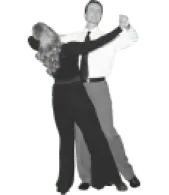
Traditional Ballroom Hold
In Contact, Close or Extended Proximity.
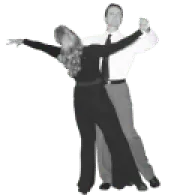
Alternate Hold Silver
Both partners release one hand to extend the arm and the other hand is placed to the shoulder or rib/back. In Closed and Outside Partner Right the left hand will be extended with the right hand to the body, in Outside Partner Left the right hand will be extended with the left hand to the body.
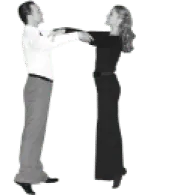
Hand Holds
Double Hand Hold (left to right and right to left), Single Hand Hold (left to right or right to left), Crossed Hand Hold (right to right and left to left), Handshake Hold (right to right or left to left).

Alternate Hold Bronze
Follower may release left hand to extend left arm, and/or the Leader may lower left hand holding the Follower’s right hand and switch from Clasp to Link Hold.

Frame hold
With elbows up in a dance frame, hands connect to partner’s back, shoulder, elbow or wrist. Follower’s hand/arm is placed on top of the Leader’s arm(s). Combinations of a Frame Hold and a Single Hand Hold are allowed.
SHADOW HOLD EXAMPLES:

Right Shadow Hold
Right hand on right side of Follower’s body, left hand holding the Follower’s left hand/wrist/forearm.
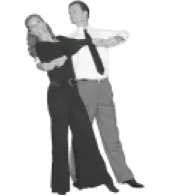
Alternative Shadow Hold Example
Right arm behind Follower’s back, right hand holding her left hand and left hand holding her right hand. Follower’s arms are crossed in front of her body just below waist level with her right arm above her left arm (Cuddle/Cradle/ Sweetheart Hold).
MORE ADVANCED HOLDS:
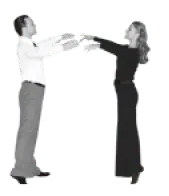
No Hold
There is no physical contact with the other partner.

Hand(s) to Body
Partners have no other point of contact other than a hand or hands to the partner’s body.
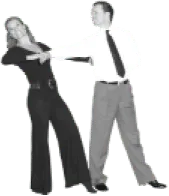
Hammerlock
Double Hand Hold or One Hand Hold with one partner having turned to right or left under joined hand(s) ending with one partner’s arm across his/her lower back. In any Shadow or Contra Position.
Holds are defined as the points of contact between the partners (see the Chart for the holds that are allowed at each level of Bronze, Silver and Gold).

Traditional Ballroom Hold
In Contact, Close or Extended Proximity.

Alternate Hold Silver
Both partners release one hand to extend the arm and the other hand is placed to the shoulder or rib/back. In Closed and Outside Partner Right the left hand will be extended with the right hand to the body, in Outside Partner Left the right hand will be extended with the left hand to the body.

Hand Holds
Double Hand Hold (left to right and right to left), Single Hand Hold (left to right or right to left), Crossed Hand Hold (right to right and left to left), Handshake Hold (right to right or left to left).

Alternate Hold Bronze
Follower may release left hand to extend left arm, and/or the Leader may lower left hand holding the Follower’s right hand and switch from Clasp to Link Hold.

Frame hold
With elbows up in a dance frame, hands connect to partner’s back, shoulder, elbow or wrist. Follower’s hand/arm is placed on top of the Leader’s arm(s). Combinations of a Frame Hold and a Single Hand Hold are allowed.
SHADOW HOLD EXAMPLES:

Right Shadow Hold
Right hand on right side of Follower’s body, left hand holding the Follower’s left hand/wrist/forearm.

Alternative Shadow Hold Example
Right arm behind Follower’s back, right hand holding her left hand and left hand holding her right hand. Follower’s arms are crossed in front of her body just below waist level with her right arm above her left arm (Cuddle/Cradle/ Sweetheart Hold).
MORE ADVANCED HOLDS:

No Hold
There is no physical contact with the other partner.

Hammerlock
Double Hand Hold or One Hand Hold with one partner having turned to right or left under joined hand(s) ending with one partner’s arm across his/her lower back. In any Shadow or Contra Position.

Hand(s) to Body
Partners have no other point of contact other than a hand or hands to the partner’s body.
Positions
Positions refer to the relationship of the partners’ bodies to one another no matter what the hold (see the GSS ELEMENTS Chart for the positions that are allowed at each level of Bronze, Silver, and Gold).

Closed
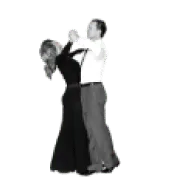
Outside Partner Right or Left
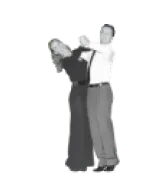
Promenade
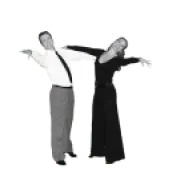
Counter-Promenade
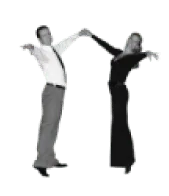
(Open) Facing

Right Angle/ 90 Degree
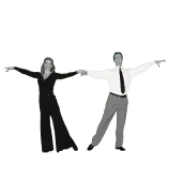
Right Side and Left Side
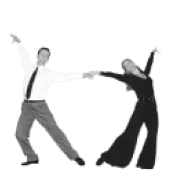
Inverted Left Side (CP) and Inverted Right Side (PP)
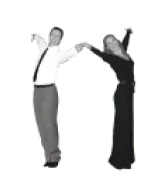
Back to Back
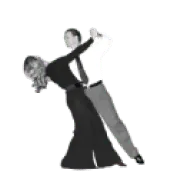
Same Foot Lunge
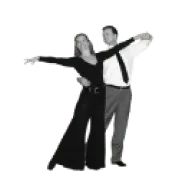
Right Shadow and Left Shadow
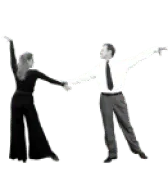
Contra
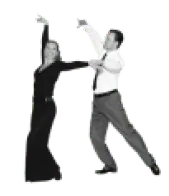
Same Foot Lunge
note
Right Shadow, Left Shadow, Tandem may have Follower in front or behind.
Proximities
Proximity refers to the distance between the partners. See the GSS ELEMENTS Chart for the proximities that are allowed at each level of Bronze, Silver and Gold.
contact
Body to body contact.
close
Close enough to take Traditional Hold with no body contact.
Extended
Within arm’s length of the partner and with any hold.
apart
Within arm’s length distance apart without a hold, couple could return to body contact by one partner taking one step towards the other.
away
Further apart than arm’s length, partners would not be able to touch or take any hold. Couple could return to body contact by both taking one step each towards partner. Further away than one step each is not permitted in closed syllabus.
Feet
Proximity refers to the distance between the partners. See the GSS ELEMENTS Chart for the proximities that are allowed at each level of Bronze, Silver and Gold.

Opposite foot
If one partner is on the right foot the other partner must be on the left foot, and vice versa.

Same foot
Both partners are on the right foot at the same time or both partners are on the left foot at the same time.

Closing feet for Bronze
Passing feet (continuity style) for Silver and above.
Timing
Proximity refers to the distance between the partners. See the GSS ELEMENTS Chart for the proximities that are allowed at each level of Bronze, Silver and Gold.
Example 1,2,3 = three weight changes.
Example 1, 2, & 3 = four weight changes. Timings in parentheses indicate that there is no weight change on that count.
Example QQ(S) = two weight changes.
Smooth Elements Rules and Restrictions for Competitions
Bronze Restrictions for All Smooth Dances
All couples must start in Traditional Hold in any allowable Bronze position or proximity, (including the follower’s left hand being placed on the leader’s right upper arm or shoulder), and must remain in this hold for the first 4 bars they dance. Alternate Hold and Double Hand Hold do not count towards this requirement.
For all closed syllabus Bronze and Silver levels an additional 8 bars must be danced in the Traditional Ballroom Hold (as defined) at any time during the first minute of music for a total of 12 bars.
Viennese Waltz allows the traditional single *Curtsey and Bow before taking hold. No other entrances are allowed. Posing or poses prior to taking hold will be considered an entrance.
Once the initial hold is taken, couples must always maintain an allowable hold and may not completely separate.
Feet must close, no passing feet (continuity style) in Waltz, Foxtrot or Viennese Waltz except in permitted elements, a Closed Finish must follow these elements. See the specific dances for allowed elements.
One underarm turn at a time is the maximum allowed in the Bronze level. Underarm turns are measured by how many times a partner turns under the connected arms.
No Fallaway actions (including Fallaway Grapevines). Fifth Position and Open Breaks are not considered Fallaway actions and are allowed.
No consecutive Pivots to left or right, 1 Pivot only is allowed.
Partners must remain on Opposite Foot with no foot changes, fakes, solo, or Same Foot figures except for the *Tango Shadow Rocks.
No syncopations are allowed other than the *Promenade Chassé allowed in Waltz and Foxtrot. No syncopated underarm turns.
No Picture Lines i.e. Contra Check, Oversway, Lunges, etc.
Couples must always remain in a standing position. No changes of levels.
No embellishments of syllabus figures. No Head Rolls, Foot Flicks, syncopations or delayed timings unless specifically approved under timings of each dance.
Feet must always remain close to the floor (no aerial rondés, developés, flicks, leg crawls, etc.).
Bronze Smooth Waltz Restrictions
All general restrictions for Bronze Smooth dances apply as well as the following rules specifically for Waltz.
Partners may not completely separate. Open/extended work is limited to Single or Double Hand Holds and may not last for more than 8 consecutive bars (24 beats).
No consecutive Pivots to left or right, 1 Pivot is allowed and must be preceded and followed by a Hesitation.
Feet must close on third count, no passing feet (continuity style) except in permitted elements, a Closed Finish must follow these elements (Hesitations, Breaks, Cross-Body Lead, Chassés, Waltz Grapevine, Underarm Turns, Spin Turns, Pivots).
Bronze Smooth Tango Restrictions
All general restrictions for Bronze Smooth dances apply as well as the following rules specifically for Tango.
Partners may not completely separate. Open/extended work is limited to Single or Double Hand Holds and may not last for more than 8 consecutive bars (32 beats).
Partners must always be on Opposite Foot except for *Shadow Rocks.
No more than 4 consecutive quicks.
Although the Corté is permitted, other Picture Lines are not allowed.
No syncopations, except for the Brush Tap in the Open Fan (&S).
Bronze Smooth Foxtrot Restrictions
All general restrictions for Bronze Smooth dances apply as well as the following rules specifically for Foxtrot.
Partners may not completely separate. Open/extended work is limited to Single or Double Hand Holds and may not last for more than 8 consecutive bars (32 beats).
Feet must close, no passing feet (continuity style) except in permitted elements, a Closed Finish must follow these elements (Step Points/Swivels, Breaks, Cross-Body Lead, Chassés, Grapevines, Underarm Turns, Spin Turns, Pivots).
No more than 4 consecutive quicks, except for the *Grapevine where up to 8 consecutive quicks are allowed.
Bronze Smooth Viennese Waltz Restrictions
All general restrictions for Bronze Smooth dances apply as well as the following rules specifically for Viennese Waltz.
No syncopations are permitted.
Partners may not completely separate. Open/extended work is limited to Single or Double Hand Holds and may not last longer than 8 consecutive bars (24 beats).
Waltz timing, Hesitation timing, and Canter timing are allowed.
Feet must close on third count, no passing feet (continuity style) except in permitted elements, a Closed Finish must follow these elements (Hesitations, Breaks, Cross-Body Lead, Underarm Turns).
Silver Restrictions for All Smooth Dances
All couples must start in the Traditional Ballroom Hold in any allowable Bronze position or proximity, (including the follower’s left hand being placed on the leader’s right upper arm or shoulder), and must remain in this hold for the first 4 bars they dance. Alternate Hold and Double Hand Hold do not count towards this requirement.
For all closed syllabus Bronze and Silver levels an additional 8 bars must be danced in the Traditional Ballroom Hold (as defined) at any time during the first minute of music for a total of 12 bars.
Viennese Waltz allows the traditional single *Curtsey and Bow before taking hold. No other entrances are allowed. Posing or poses prior to taking hold will be considered an entrance.
Partners may release to No Hold for a maximum of 1 measure per occurrence at Apart or closer proximities only.
Right Shadow Position (same foot, follower in front) is restricted to a maximum of 8 consecutive bars. Left Shadow Position is restricted to one bar in *Shadow Switches in Waltz only.
Allowable Picture Lines may be held for a maximum of 2 bars on one foot.
Partners are on Opposite Foot except for the Same Foot Lunge and Right Shadow Position as noted in the individual dances. Same Foot is also allowed in Foxtrot for the *Grapevine in Left Side Position for up to 4 quicks only.
Continuous partnership Pivots are allowed for a maximum of 2 consecutive bars. Syncopated Pivots are allowed in Waltz only with no more than 1 syncopation per bar.
Couples must always remain in a standing position. No change of levels.
No dips or drops below the waist level. No Knee Drops, Sit Drops, Floor Slashes, Sit Spins, Standing Spins, Horse & Carts, Pot Stirrers, Hinges, Left Whisks, X Lines, Attitudes, Eros Lines, Throwaway Oversways.
No embellishments of syllabus figures. No Head Rolls, Foot Flicks, syncopations or delayed timings unless specifically approved under timings of each dance.
Kicks, Rondés, Developés must be no more than waist high.
Closed Silver routines must not incorporate any figures or elements specified as being allowed at the Closed Gold Level.
Gold Restrictions for All Smooth Dances
Partners must start on Opposite Foot, with any allowable hold that requires a minimum of a Single Hand Hold for the first 4 bars. No entrances are allowed. A single *Curtsey and Bow facing partner in Viennese Waltz is allowed.
At least 6 complete bars within the first minute of each dance must be danced in Traditional Ballroom Hold.
Partners may release to No Hold for a maximum of 4 consecutive bars, then must regain a connection (any allowable hold) for at least 2 bars before releasing hold again. In Viennese Waltz partners may separate for a maximum of 8 consecutive bars, then must regain a connection (any allowable hold) for at least 4 bars before releasing hold again.
The following movements are considered Open and are not allowed in Bronze, Silver or Gold Closed Syllabus events: Entrances, Dips and Drops below waist level, Knee Drops, Sit Drops, Floor Slashes, Sit Spins, Off-Balance Drags.
Kicks, Rondés, Developés must be no more than waist high.
No lifts are allowed.
Jumping, skipping or hopping is not permitted.
Continuous partnership Pivots are allowed for a maximum of 3 consecutive bars. Syncopated Pivots are allowed in Waltz only with no more than 1 syncopation per bar.
Standing Spins/ Horse and Cart may be danced for up to 4 bars. Both feet must remain on the floor for both partners. The partners’ timings do not have to match.
All supported Picture Lines are allowed (above standing waist level) up to a maximum of 4 bars on one foot.
Open Level for All Smooth Dances
There are no restrictions or requirements on holds allowed, including no time restrictions on No Hold at any distance from partner. Entrances are allowed.
No lifts are allowed. If one partner is supported by the other at least one foot must always remain touching the floor.
Kicks, Rondés, Developés may be any height.
Jumps, skips and hops are allowed. Assisted jumps allowed but the partner may not be held up (only for the same number of beats as if taken unassisted).
No restrictions on timings or syncopations including length of time in Picture Lines or Standing Spins.
At Global Smooth Certification, we've developed and refined the original Smooth Elements Chart.
Complete the course and earn your GSC Elements Chart certification at Bronze, Silver, and Gold levels applicable to judging or adjudicating both franchise and independent closed Smooth syllabi.
Master the essential elements needed to create your own unique, dynamic, and technically excellent version of closed-level Smooth.
© 2025 All rights reserved Global Smooth System LLC.

